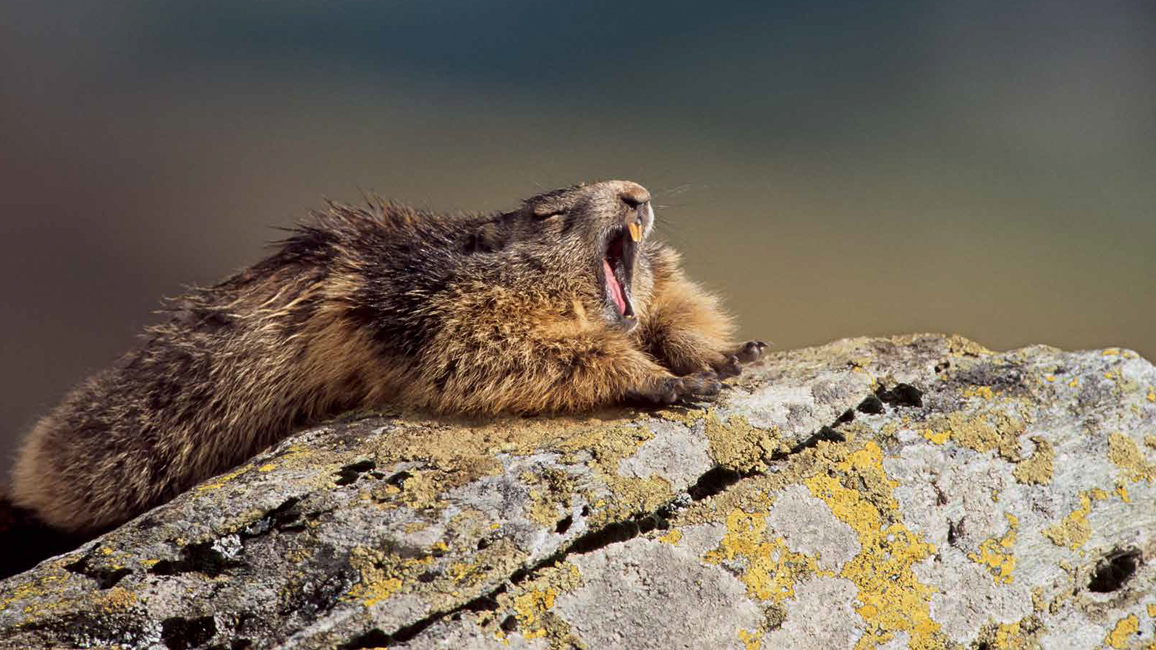
Wake Up!
By Hannah SchardtWith a yawn and a stretch, this alpine marmot (below) warms up in the spring sunshine. It has good reason to feel a little groggy: It’s been asleep for nearly six months!
Last fall, tucked safely inside a burrow, the furry marmot curled up with its family As the weather outside became harsh and cold, the marmots began a sleep that would last the rest of fall, all of winter, and part of spring. That super-long sleep is called hibernation. Some furry, warm-blooded creatures such as marmots and chipmunks do it. But they aren’t the only ones. Many toads, snakes, and even insects also choose to snooze when the temperatures drop. Read on to find out who else hibernates—and why hibernation is much more than a really long nap!
WINTER SLOW-DOWN
Winter can be a tough time for wild animals. Frigid weather makes it hard for them to stay warm. And there’s not much food to go around. Some animals migrate, or travel to another place. Some stay put and struggle through. But many animals find burrows or dens and put their lives on pause. When an animal hibernates, it stops eating, pooping, and moving. Its heart rate slows way down—from as many as 150 beats per minute to as few as five. Its body gets much cooler. (For example, a ground squirrel’s normal body temperature is around 100°F. During hibernation, it is closer to 40°F. That’s almost as cold as the food in your refrigerator!) And a hibernating animal may breathe hardly at all.
These are all ways of saving energy. Animals get energy from food. When a hibernator doesn’t have enough food to keep its body going, it does the next best thing: It powers down its body until food becomes available again.
WHO SNOOZES?
Scientists don’t all agree on what counts as hibernation. Some say that one of the most famous winter snoozers, the black bear, isn’t really a hibernator at all. While the bear sleeps away most of the coldest months, its body temperature stays pretty warm.
Even the deepest-sleeping mammals, such as ground squirrels, warm themselves up to a normal body temperature every few days or weeks. A few hours later, they go right back to hibernating. But cold-blooded reptiles and amphibians stay conked out until the air or soil around them gets warm enough to wake them up.
HIBERNATION HOW-TO
Remember the awakening animals in the top photo above? Their hibernations are as different as they are. Some garter snakes gather in large groups. They hide out in empty mammal burrows or under big rocks until spring, when they slither back out into the sunshine.
The spadefoot toad uses its strong back feet to dig deep into mud. As the mud dries up, the toad stays still and safe underground. When spring rain softens the earth around it, the toad digs its way back to the surface to eat and mate.
And that chipper chipmunk? On a warm winter day, it may wake up and nibble on the food it stashed in its burrow during fall. For a hibernator, that’s like raiding the fridge in the middle of the night!
RISE AND SHINE
With all this sleeping going on, you might think hibernators would wake up in spring refreshed and full of energy. But waking up from hibernation is hard work. Drowsy mammals have to shiver for hours to get their chilly bodies moving again. By the time they warm up, they are ready for a good meal!
“Wake Up!” originally appeared in the February 2014 issue of Ranger Rick magazine.
(Click on each image above for a closer view of the story.)



















